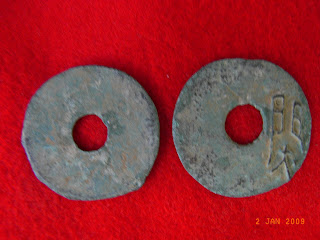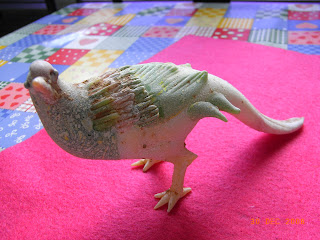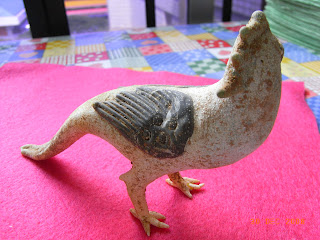
Sunday, January 18, 2009
Seven Warring States Coin -戰國七雄钱币


This coin has an inscription read : 関
This is an ancient city name: "Guan" in which I believe is the city called " Guan-Zhong" 關中
There was a story behind this coin.
There was a story behind this coin.
Under a promise issued by Prince Xin of Chu earlier, Liu Bang had assumed that he, as the one who entered Xianyang first, would be created the Prince of Guanzhong (which includes the capital Xianyang and most of Qin proper). It was a free for all. Liu Bang went to the Qin capital and swiftly captured it before any of the other groups, whilst at the same time inflicting no damage to the capital.
After the 9th battle Xiang Yu finally defeated the Qin but he was arrived GuanZhong two months after Liu-Bang. Thus Xiang Yu's march to Xian Yang was delayed. On hearing that Xiang Yu was approaching the capital, Liu Bang, taking all the treasures that he could find from the Qin's treasury, led his troops North from the capital in order to avoid a collision with oncoming Xiang Yu.
Xiang Yu eventually arrived at the capital. He was very angry as he missed the fame for being the first to capture the Qin capital. He was further infuriated by the news that all the treasure was taken away by LiuBang. He ordered his troops to kill all the royal members of the Qin Court. Even the infant ruler of the Qin could not escape the butchering bythe victors. Xiang Yu also ordered all the buildings in the capital,including the palaces, to be set ablaze. The capital was razed to the ground and thus marked the fall of the Qin dynasty.
After this, Xiang Yu ordered his troops to prepare to attack Liu Bang. Knowing that Xiang Yu was furious and planned to attack him, Liu Bangbrought the treasure back to the capital and asked him for forgiveness.Xiang Yu forgave him. After the transfer was completed, Xiang Yu intendedto take all the treasures back to the East, his home base.
The Seven Warring States formed from the weakening of the Zhou Dynasty. They were, in alphabetical order by pinyin:
Chu (楚)
Han (韓/韩)
Qi (齊/齐)
Qin (秦)
Wei (魏)
Yan (燕)
Zhao (趙/赵)
Chu (楚)
Han (韓/韩)
Qi (齊/齐)
Qin (秦)
Wei (魏)
Yan (燕)
Zhao (趙/赵)
Seven Warring States Money-戰國七雄钱币


This is another priceless piece of coin from the late Eastern Zhou period. ( 722BC to 430BC ).
This coin is mint from one of the seven kingdoms.
This coin has an inscription read: "共口金化"
The Seven Warring States or Seven Kingdoms (traditional Chinese: 戰國七雄; simplified Chinese: 战国七雄; pinyin: zhàn guó qī xióng; literally "Warring States [period] seven great powers") refers to the seven warring states in China during the Warring States period in Chinese history. The Seven Warring States formed from the weakening of the Zhou Dynasty. They were, in alphabetical order by pinyin:
Chu (楚)
Han (韓/韩)
Qi (齊/齐)
Qin (秦)
Wei (魏)
Yan (燕)
Zhao (趙/赵)
Chu (楚)
Han (韓/韩)
Qi (齊/齐)
Qin (秦)
Wei (魏)
Yan (燕)
Zhao (趙/赵)
The eventual winner of the wars was the state of Qin, whose ruler Qin Shi Huang established the first imperial dynasty in Chinese history. It is probable that China is named after Qin。
This is a big rounded coin.
Big Money of Ji from Eastern Zhou

The first rounded coin from Ancient China was mint in the Eastern Zhou Dynasty period dated around 770BC to 221BC.
There were 12 feudal noble princes (Zhuhou 十二諸侯)during the Eastern Zhou Dynasty of the Autumn Spiring period.The inscription on coin " JI" probably derive from one of the Zhou feudal prince named " Ji" or probably named after a province's name.
What is Liu-Li 硫璃 Precious Crystal For Sale







What is Liu Li "硫璃" ?
These are Ancient Crystal Ornaments made from volcanic larva which is a kind of crysal glass that form multi-colors.
It is known as " Liu Li" 硫璃"in Chinese.
It started since Autumn Spring period dated about 720BC to 430 BC .
The art of Liuli has been an honored craft among the Chinese for over 2500 years. Its origins are cloaked in mystery but its beauty is easy for anyone to appreciate. A rich array of colors are enhanced by the flow of light through the material.
Liuli was only to be used by royal families, and few knew how to make it. The mixture of color during the production process is very unpredictable and the failure rate is quite high, causing LiuLi's prices to remain high even till today. It is very fragile and easily breakable. Must handle with extra care. Each art piece are rare, never get identical piece.
You can refer to my next blog on Modern Liu Li.
I noticed a shop located at Takashimaya selling several ornaments of Modern Liu Li. Unfortunately today's LiuLi, people promote this products for Fengshui and prosperity purpose.
It is really too beautiful to collect.......But the prices of LiuLi are very beautiful too.
I can sell cheaper than market value.
Friday, January 16, 2009
What is CUNEIFORM?





What is " Cuneiform"?
"Cuneiform" is the Earliest Form of Writing in early civilization.
I am sure you have not seen such writing before.The predominate writing material used in the ancient Near East was clay, formed into small tablets and impressed with wedge-shaped symbols called cuneiform writing, and then baked in an oven or dried in the sun.
Note: Near East is refer to the the location of Middle-East today
Thousands of clay writing-boards have been uncovered by archaeologists. Cuneiform is the earliest -known system of writing. It was invented in Sumer around 3000 B.C. The name cuneiform comes from the Latin word "cuneus", meaning wedge.
The ancient Sumerians introduced their word system throughout the Near East. Cuneiform was so diverse and adaptable to various languages that it spread quickly and survived up until the first century B.C.
According to Babylonian beliefs Nabu, the god of scribal arts gave cuneiform to them.
It was the writing used during the time of Abraham, Isaac and Jacob before the Hebrew Language was established at Mt Sinai.
These cuneiform writing is known as " AKKADIAN" Cuneiform.
It is written throughout the lands of Mesopotamia( Between Iran/Turkey and Iraq.) This kind of Cuneiform writing no longer active anymore in the middle-east.
I acquired 1 piece of this clay tablet Cuneiform through an auction-house.
It was dated about 4,000 BC.
It was a writing about a contract/agreement which was made between two parties.
Thursday, January 15, 2009
Ancient China BianZhong 編鐘 Chimes






The 65 bronze chimes from the tomb of Marquis Yi of Zeng (433 B.C.) ( 曾侯乙; pinyin: Zēng Hóu Yǐ) are considered as one of the most fortunate discoveries in China archeology.
The tomb contained the remains of Marquis Yi of Zeng. Zeng was a minor state subordinate to its powerful neighbor, Chǔ-State, during the Warring States Period.
In 1981, a less well-preserved and smaller tomb was discovered about 100 meters away, containing the remains of a woman related to Marquis Yi. This tomb contained a less extravagant set of 36 bronze bells and other musical instruments.
The most famous discovery at the tomb is the large set of Bianzhong 編鐘, which required a cast of five members to be played, and were struck with wooden mallets to produce music. The bells are two-toned, producing two distinct tones when struck at the center or the side; this property is enabled because the bells have an almond-shaped cross-section. The bells cover a range of five octaves. The collection also contains a non-matching bell, a memorial to Marquis Yi from King Hui of Chu State, recording King Hui's rushed trip from the west to create the bell and attend the Marquis's funeral during the 56th year of King Hui's reign; the inscription on the bell dates the event to 433 BCE. The bells were inscribed with music notations that detailed the relationship among the pitch standards of Zeng, Chu and Zhou.
Other musical instruments in the ensemble include stone chimes. Various string instruments were also discovered in the tombs, including the twenty-five stringed se, ten-stringed qin and five-stringed zhu.
The most famous discovery at the tomb is the large set of Bianzhong 編鐘, which required a cast of five members to be played, and were struck with wooden mallets to produce music. The bells are two-toned, producing two distinct tones when struck at the center or the side; this property is enabled because the bells have an almond-shaped cross-section. The bells cover a range of five octaves. The collection also contains a non-matching bell, a memorial to Marquis Yi from King Hui of Chu State, recording King Hui's rushed trip from the west to create the bell and attend the Marquis's funeral during the 56th year of King Hui's reign; the inscription on the bell dates the event to 433 BCE. The bells were inscribed with music notations that detailed the relationship among the pitch standards of Zeng, Chu and Zhou.
Other musical instruments in the ensemble include stone chimes. Various string instruments were also discovered in the tombs, including the twenty-five stringed se, ten-stringed qin and five-stringed zhu.
Due to favorable conditions of tomb preparation, soil, and soon natural water filling, the bronze of the bells survived fully intact.
A unitary ensemble of 65 bells, with 130 discrete strike tones, was excavated in a fully preserved state 1978 in the Chinese province of Hubei from the tomb of the Marquis Yi of Zeng from 433 B.C. The ensemble's tuning system could now for the first time be determined by applying exclusively empirical methods. Only pitch data, hanging order, and tone names on the bells were considered. The results show (1) a norm tone of F4 ~ 345 Hz (ca. F4-20 Cent, re modern A4 = 440 Hz), (2) a six-tone standard scale of D-E-F-G-A-C with F#, G#, A#, B, C#, and D# as accidentals, and (3) a third-oriented tuning with equally tempered fifths (~696 Cent) in the series C;G;D;A;E.
Two-tone bells were common in China between 1200 and 200 B.C. After that the advanced know-how to cast them was lost, and it could not yet be fully recovered in our days. The bells have an eye-shaped cross-section and vibrate in one of two modes, depending on where they are struck. A strike in the middle of the front makes frontside and backside vibrate as whole units and produces the lower tone sui. A strike between the middle of the front and a side edge makes frontside and backside vibrate as two units each and produces the higher tone gu. If struck correctly, both tones are fully independent, each with its own fundamental and harmonics.
Quality and timbre of the two tones are fully compatible, and they are both marked by tone-name inscriptions on the bells. Thus, both were intended to be used in musical practice. Of the 33 bells in the melody section of the Zeng ensemble, 21 have a sui-gu interval of a minor third (mean 312.4 Cent, SD 13.8), 10 have one of a major third (mean 403.1 Cent, SD 18.1), and two have apparently mistuned ones with 244 and 342 Cent .
The 65 Zeng bells prove that about 2500 years ago the Chinese had fifth generation, fifth temperament, a 12-tone system in musical practice (not just in theory), a norm tone for an orchestral ensemble, an integration of fifths and thirds in tuning, and a preference of pure thirds over pure fifths. At this point in history, China was 2000 years ahead of Europe, not only in bell casting, but also in musical acoustics. One may hope that replicas of ancient Chinese bells that match the quality of the best originals can soon be made, and that appropriate mallets are used to play them. One may also hope that musicians will then make full use of the Gamelan-like potentials of large bell ensembles, as those from the Marquis Yi of Zeng.
The collection that I aquired ten years ago was the Chimes from Eastern Zhou period.( About 771 BC-221 BC ) The set consist of Seven Chimes.
I have another collection from the Warring States.( About 453BC-221C ) The set consist of Thirteen Chimes.
Another set of my collection come from Eastern Zhou period. But this is a miniture set which is identical to the Marquis of Yi Zeng's Chimes. ( About 453BC ) The set consist of 21 chimes. It is also one of my favorite.
Most of these chimes have Bronze Oracle Inscription.
Several sets of Bianzhong were imported to the Korean court during the Song Dynasty. Known in Korea as pyeonjong, the instrument is still used in Korean court music. A similar instrument in Japan is called the Hensho.
I will upload these chimes when I have these photo taken.
Subscribe to:
Posts (Atom)














